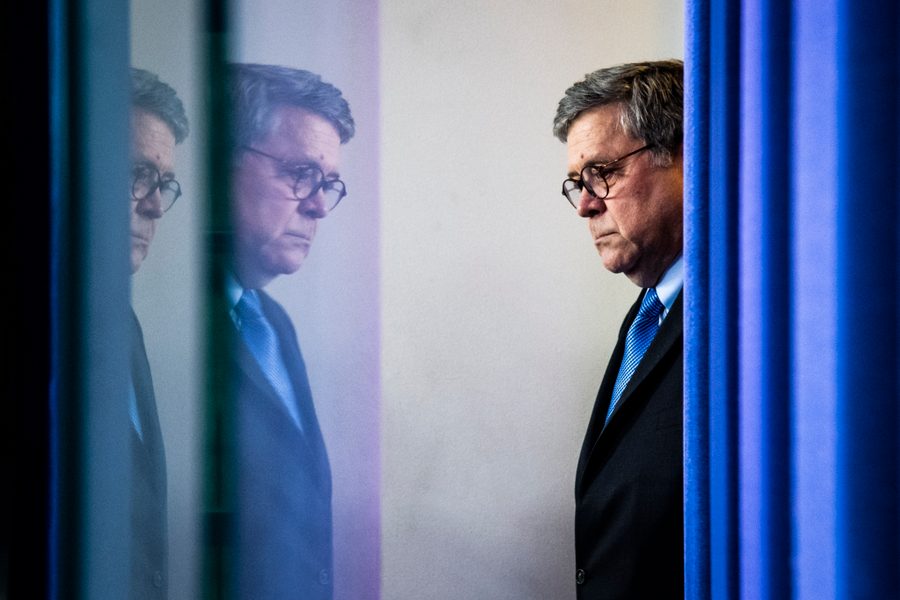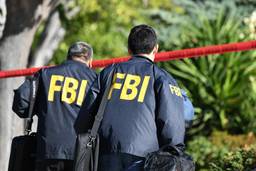Barr’s New Task Force Is a Blatant Attempt to Target Racial Justice Protesters
By embracing preventive policing, the task force aims to eliminate the threat of dissent.
Chip Gibbons

On June 26, Attorney General William Barr announced the creation of a new task force on “violent anti-government extremists.” Made up of representatives of the U.S. Attorney’s Office, the Federal Bureau of Investigation (FBI) and “other relevant components,” the task force comes in the midst of a nationwide uprising against racism and police violence. While Barr’s initial statement cited as examples of “violent anti-government extremists” both the right-wing “Boogaloo” movement and “Antifa,” the taskforce is primarily as a right-wing reaction to racial justice protests erupting across the country.
This development is in keeping with the FBI’s history of spying on nearly every major social movement, from the anti-Vietnam war and civil rights movements, to Occupy Wall Street and Black Lives Matter. And it comes as Barr and Trump have repeatedly tried to turn “Antifa,” or anti-fascist ideology, into an all-purpose boogeyman. Within this context, the creation of the new task force on violent anti-government extremism should be viewed as a dangerous act aimed at policing the politics of racial justice protesters.
The problem with preventive political policing
The task force is not just tasked with prosecuting violent anti-government extremists who engage in domestic terrorism, but preventing these groups or individuals from engaging in violence before it occurs and to “ultimately eliminate it as a threat to public safety and the rule of law.” While preventing violence before it occurs may sound noble, preventive policing is fraught with abuse. After all, it inherently involves law enforcement action or intrusive intelligence gathering against people who have not committed any crime based on the notion that law enforcement and intelligence can successfully pinpoint potential criminals.
Mike German, a former FBI agent and current fellow with the Brennan Center for Justice’s Liberty & National Security Program, told In These Times the claim that “law enforcement or intelligence officers can accurately predict who will engage in criminal behavior in the future is a dubious assumption.” Such a preventive framework, says German, “justifies broad law enforcement or intelligence activities as necessary to serve the laudatory goal of preventing crime where the evidence of success — no crime occurring — justifies the action taken even when there is no evidence the tactics prevented the crime rather than that the prediction that a crime would occur was false.”
The language about prevention is also a red flag for those familiar with the FBI’s use of radicalization theory, which has been central to its Countering Violent Extremism initiative, a counter terrorism program aimed at identifying individuals likely to become terrorists. Radicalization theory posits that one becomes a terrorist by adopting ideas the FBI deems radical or extremist. This theory rests on the premise that there is set path by which one radicalizes into becoming violent. As this path has identifiable points, knowing those points allows to law enforcement and intelligence to intervene before an individual is a full fledged terrorist.
The underlying methodological assumptions of this theory and the idea that there is a set path to terrorism are widely disputed. Civil libertarians also point out that political speech the government deems radical or extremist is still protected by the First Amendment. Claiming that espousing political views disfavored by the government is the first step to becoming a terrorist opens the door to political surveillance.
This is apparent in an online game created in 2016 by the FBI to teach teenagers how to prevent violent extremism. In one scenario, students are given a list of fictional social media posts and asked to identity the one “most likely a violent extremist looking for new recruits.” The correct answer is a post asking if anyone is interested in joining him at “that awful animal testing lab” to “send them a ‘powerful’ message and shut them down once and for all.” It’s a vague post that could refer to a destructive act, but it could also refer to mere political protest. The message it sends to students is clear: certain forms of political speech are suspicious. (The initial version of this game used as an example of reportable behavior a student with a Muslim-sounding name discussing an overseas trip. After civil rights groups objected to the game’s promotion of racial profiling, this specific example was changed. Civil rights groups still objected to the game on grounds that it promoted racial and religious profiling.
This game isn’t the only reason for concern. A 2010 FBI primer on anarchist extremism describes it as encompassing “a variety of ideologies, including anti-capitalism, anti-globalism and anti-urbanization.” In 2001 congressional testimony about the terrorist threat posed by “left-wing and Puerto Rican extremist groups,” the FBI director defined those groups as professing “a revolutionary socialist doctrine and view themselves as protectors of the people against the ‘dehumanizing effects’ of capitalism and imperialism.”
If political speech leads to one becoming a terrorist, then preventive policing based in the radicalization framework means policing political speech. As German told In These Times, “History shows the government often posits that political activities and speech are precursors or indicators of future violence, so the whole prevention framework serves to justify the suppression of political opposition rather than crime.”
The focus on not just prosecutions, but eliminating the threat of extremism, is evocative of one the darkest chapters in the FBI’s history. While the FBI has a long track record of political surveillance, from 1956 to 1971, the FBI went a step further. Under the Counterintelligence Program (COINTELPRO), the FBI carried out what the Church Committee, the landmark Senate investigation into US intelligence operations, labeled a domestic covert action against American citizens viewed as threatening “the existing political and social order.” COINTELPRO drew upon “techniques of wartime” designed to counter hostile foreign agents and applied them to domestic political movements.
The FBI created COINTELPRO in 1956 because it was frustrated with what it perceived as a lack of law enforcement avenues to destroy the Communist Party. Fearing it was unable to prosecute individuals whose speech the FBI considered a national security threat, it moved into actively trying to “neutralize” or “disrupt” these groups. As historian Ellen Schrecker succinctly put it, FBI Director J. Edgar “and his men decided to use dirty tricks instead of criminal prosecutions to neutralize the party.”
COINTELPRO quickly expanded beyond the Communist Party, but the initiation of new operations was always premised on the FBI’s belief that, for whatever reason, prosecution and normal law enforcement avenues were foreclosed when it came to thwarting the movement in question. As a result, COINTELPRO by its very design often targeted entirely lawful First Amendment-protected political organizing for neutralization.
Targeting racial justice protesters
The task force’s stated target gives further cause for concern that it will allow the FBI to ramp up its history of political policing. The phrase “anti-government extremism” entered the FBI lexicon as part of a shift in how the FBI defines domestic terrorism. In 2017, the FBI claimed it recognized the existence of nine “persistent extremist movements”: “white supremacy, black identities, militia, sovereign citizens, anarchists, abortion, animal rights, environmental rights and Puerto Rican Nationalism.”(Abortion extremism, per the FBI, refers not just to anti-choice actors, but pro-choice ones, as well.) The term Black Identity Extremism, which was revealed initially when an FBI intelligence assessment was leaked to Foreign Policy, garnered significant backlash. Faced with Congressional scrutiny, FBI director Christopher Wray told Congress the bureau no longer used that term. Instead, the FBI now recognized four categories of domestic terrorism: racially motivated violent extremism, anti-government/anti-authority extremism, animal rights/environmental extremism, and abortion extremism.
Gone was not only Black Identity Extremism, but white supremacist, anarchist, sovereign citizen, militias, and Puerto Rican extremism. Or at least the terms were gone.
A second leak of FBI documents shows that the definition of Black Identity Extremism had hardly been eliminated, but incorporated wholesale into racially motivated violent extremism. Lawmakers criticized this category for merging Black Identity Extremism and white supremacy. A letter signed by seven U.S. senators states that doing so creates not just a false equivalency, but “obfuscates the white supremacist threat.”
The terms “anti-government” or “anti-authority extremism” works according to the same logic. Right-wing militias and anarchist protesters are brought together in one unified category.
The obfuscatory nature of the FBI’s new domestic terrorism categories is on full display with Barr’s task force on violent anti-government extremism. While it’s clear Barr is targeting “antifa,” a catch-all for leftwing protesters, he is also able to pretend he is focusing on rightwing groups.
This isn’t the first time antifa has been mentioned. In late 2017, director Christopher Wray, when asked by Congress if the FBI was investigating “antifa,” explained that antifa or anti-fascism was a political ideology. The FBI did not, according to Wray, investigate ideology. The FBI, however, had opened numerous “anarchist extremism” investigations into individuals supposedly motivated to violent action “by a kind of an antifa ideology,” he explained. The FBI’s own primer on the domestic terrorism threat of anarchist extremism references this group’s and anti-globalist ideologies. This is all firmly within the jurisdiction of a task force focusing on the sinister sounding violent anti-government extremism.
A new Red Scare?
Barr isn’t hiding the ball: He’s attacked antifa and the left by name. In a press conference on George Floyd protests, Barr declared “in many places it appears the violence is planned, organized, and driven by anarchic and left extremist groups, far-left extremist groups, using antifa-like tactics.”
This is clearly the language of a Red Scare. And it isn’t just Barr who’s parroting it.
Rep. Matt Gaetz (R-Fla.) tweeted “Black Lives Matter is a Marxist movement.” On the floor of the house, Rep. Andy Biggs (R-Ariz.) mused that the current situation “reminds me an awful lot of” the Bolshevik Revolution. Sen. Tom Cotton (R-Ark.), who has called for the military to be used against protesters, proclaimed, “Look at what’s happening in Seattle. Revolutionaries, anarchists have taken over city government buildings.” In the same piece, he claimed some on the left had “adopted the spirit of a Jacobin mob in the French Revolution, the Reign of Terror trying to completely erase our culture and our history.”
And then there’s Trump.
An executive order issued on June 26, supposedly to protect statues and monuments, states, “Many of the rioters, arsonists and left-wing extremists who have carried out and supported these acts have explicitly identified themselves with ideologies — such as Marxism — that call for the destruction of the United States system of government. Anarchists and left-wing extremists have sought to advance a fringe ideology that paints the United States of America as fundamentally unjust and have sought to impose that ideology on Americans through violence and mob intimidation.”
Standing before Mt. Rushmore on July 3, Trump decried “far-left fascism” and warned of a “left-wing cultural revolution” “designed to overthrow the American Revolution.”
The following day, at a Fourth of July “Salute to America,” Trump carried on with similar themes, declaring, “We are now in the process of defeating the radical left, the Marxists, the anarchists, the agitators, the looters, and people who in many instances have absolutely no clue what they are doing.”
While Trump has resorted to these incendiary denouncements of racial justice protesters, this rhetoric did not entirely begin with the nationwide uprising against police brutality. At the 2019 State of the Union address, Trump proclaimed America would “never be a socialist country,” a claim he has again made at campaign rallies. But amid escalating Covid-19 deaths, mass unemployment and a looming eviction crisis, Trump appears to be ratcheting up his rhetoric. A nationwide uprising against police racism and an insurgent democratic socialist movement has challenged the political consensus. With sinking approval ratings, Trump is clearly desperate. Trump and the far-right forces that have chosen him as their avatar are clearly trying to retain their grip on power with bombastic, Red Scare rhetoric.
The FBI has always been central to Red Scares in the United States. The height of the early 20th century Red Scare came when the FBI’s newly minted intelligence division, headed by its future director J. Edgar Hoover, gathered dossiers on radicals and carried out the Palmer Raids. During the Cold War, “the FBI was the bureaucratic heart of the McCarthy era. Barr’s creation of the task force on violent anti-government extremism is clearly part and parcel of this legacy. It will be used to go after political opponents and police the politics of the left. Reining in the FBI’s political policing is not only vital to protecting civil liberties, but defending the movement for racial justice it is targeting.






